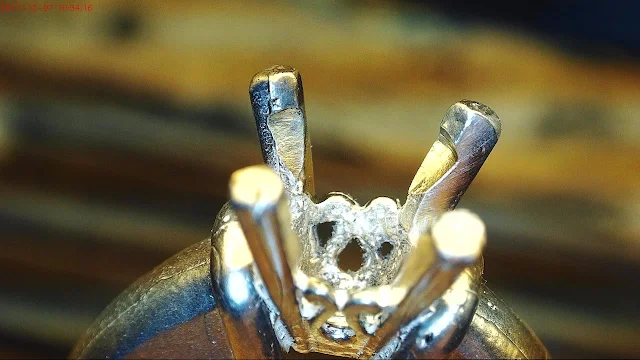As this IS A REPEATED PHOTO, I cannot avoid displaying this photo again. It is here where the Flat graver comes in handy while setting any diamond in a '4-claw mounting'.
Remember this one important rule: DON'T USE A FILE TO CLEAN THE SIDES OF THE CLAWS. The Flat graver technique was taught to me 65 years ago, and it's now your turn to learn it.
Lay your Flat graver where the groove of the 156C bur was cutting into the metal.
From this point down, you should cut into the metal just at the edge where the stone will be sitting. You need to remove every 'sliver of metal' that has no need to be there.
It is nearly impossible to use this technique when the stone has been set.
This has to be done on ALL OF THE 4 CLAWS. KEEP YOUR GRAVER SHARP TO DO THIS PRECISION CLAW CLEANING.
Although this is a new stone setting, it looks like it needs to be re-tipped, why is this? There is little amount of metal on all of the 4 claw tips. Under close examination: the stone is at the correct height, but the claws are too short.
These are my 'working wheels' they are used specifically in removing any deep or superficial marks in the metal.
These Pumice wheels come in flat-faced or Tapered surfaces. The Pink colours are of #1,000 grit while the Blue colours are of #180 grit.
This photo shows good-looking two claws, but the "V" shaped claw that is holding the point of the stone lacks any security. Mediocre claw design.
Instead of using a large steel file to reduce the claw height, why not use a different process?
I use my 'Snap-on, Emery wheel' to do the claw reduction The grit that I use is a "Medium Grade" Emery wheel.
As I wrote in the previous essay the claw carving was not properly used. The claw on the left is not acceptable, now compare the carving to the claw on the right. There is no comparison between them both.
When you are attempting to set any large diamond, examine the stone setting with your 10x <=>15x power loupe.
If you observe that the claws are not fully sitting on the 'Crown Facets', what would you do next?
The next step is to use a saw blade and recut the claw tip thus making the tip of the claw rest correctly on the stone.
This 'claw-recutting' MUST NEVER GO BEYOND THE GIRDLE OF THE STONE.
The result is that the claw tip will fully mould itself to the stone.
You can see that there is an ample amount of metal available for claw trimming. This is what we are aiming for in these 3 essays.


.jpg)





No comments:
Post a Comment